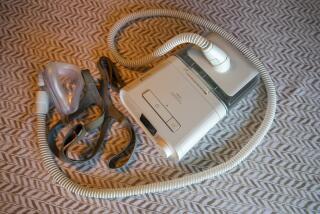SensorMedics Ventilator Is Given FDA Approval : Health care: The device uses high-frequency vibrations to gently force oxygen into the lungs of premature babies in smaller puffs but at a faster rate.
YORBA LINDA — SensorMedics Corp. said Tuesday that it has received approval from the U.S. Food and Drug Administration to begin marketing a new type of ventilator that can save the lives of prematurely born infants who struggle to breathe when standard equipment fails.
George Holmes, SensorMedics’ chief executive, said the small, privately held Yorba Linda company got a letter Friday from the FDA approving commercial use of the company’s Model 3100 High Frequency Oscillatory Ventilator on premature infants weighing up to 10 pounds.
Holmes said that unlike traditional ventilators that pump large bursts of oxygen into a patient’s lungs, SensorMedics’ instrument uses high-frequency vibration to more gently force oxygen into the lungs in smaller puffs but at a faster rate.
The advantage of the oscillatory ventilator, he said, is that it can be used on immature or weakened lungs without causing damage.
He said the FDA approval was based on the results of tests using the ventilator on 120 premature infants at eight medical center sites over four years. The ventilator was used only when more traditional methods failed, he said, adding that it was effective in most cases. In addition, the company reports that more than 300 other infants who were not part of the structured clinical studies were treated with the ventilator under a “humanitarian rescue” provision of FDA regulations that allows experimental methods to be employed when there is no other alternative to save a life.
SensorMedics’ ventilator was in development for about nine years, a process that was delayed with the transfer of patent rights among companies. Holmes said SensorMedics acquired the technology when it bought part of the medical division of Gould Inc., based in Morton Grove, Ill., in 1987.
Holmes said he has received orders this week for the ventilator from physicians who operate neonatal intensive care units. Within two years, he said, he expects the neonatal market to generate about $10 million a year in additional sales for the company.
SensorMedics, which expects total sales of $50 million this year, also manufactures computerized-diagnostic equipment used to detect such diseases as asthma and emphysema by measuring a patient’s respiratory functions and metabolism. Holmes said SensorMedics eventually hopes to win FDA approval to expand the use of its ventilator to older children and adults, who he figures represent another $35 million a year in potential sales.
Perhaps the most dramatic application of the ventilator to date, Holmes said, was to prevent the death of an 11-year-old boy at Texas Children’s Hospital in Houston who was having difficulty breathing after lengthy lung surgery and repeated bouts with pneumonia. When air was pumped into his lungs with a conventional ventilator, the stitches opened and the air leaked out.
Although the ventilator was still experimental, Holmes said, the boy’s doctors obtained permission to try it on the boy as a last resort. According to SensorMedics’ records, after 15 days on the machine the boy’s lungs began to heal and within a month he was breathing on his own.
Despite such successes, SensorMedics may have a tough road ahead. It faces immediate competition from two other companies--Bunnell Inc. of Salt Lake City, and Infrasonics Inc. of San Diego--which within recent years have obtained FDA approval of other models of high-frequency ventilators based on different technologies. Also, new drugs have been developed as an alternative for treating some lung problems in infants.
Bunnell Inc., which was the first to gain FDA authorization for a high-frequency ventilator in June, 1988, has since sold its equipment to 150 hospitals, including Cedars- Sinai Medical Center and Children’s Hospital in Los Angeles and Martin Luther Hospital in Anaheim. “We got a jump on the market,” noted David Platt, the company’s customer service manager.
Platt acknowledged that SensorMedics’ ventilator has an advantage over the Bunnell and Infrasonics instruments in that the FDA has approved its marketing for use on premature infants without first showing that more conventional ventilators will not work. But he also noted that SensorMedics’ ventilator, which costs $25,000, is $1,000 more expensive than the Bunnell model.
Dr. Robert deLemos, chairman of the department of physiology at Southwest Foundation for Biomedical Research, a nonprofit organization in San Antonio that did the basic research on the SensorMedics ventilator, said it is easier to use than the others and can treat the smallest infants with much smaller volumes of oxygen.
“I think it will save babies’ lives,” he said. “Every nursery in the country sees babies who will benefit from this ventilator.”
More to Read
Inside the business of entertainment
The Wide Shot brings you news, analysis and insights on everything from streaming wars to production — and what it all means for the future.
You may occasionally receive promotional content from the Los Angeles Times.










